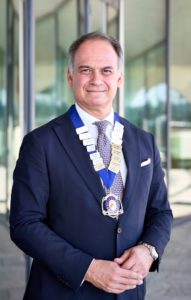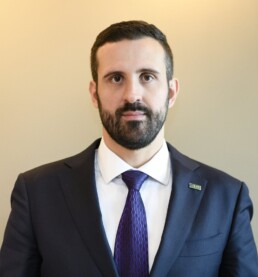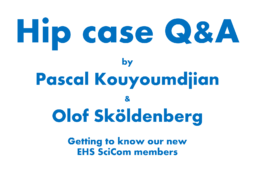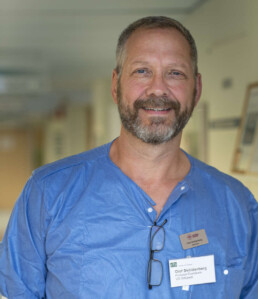 Dear EHS Members,
Dear EHS Members,
Just over 100 days until I have the honour to welcome you to my home town of Thessaloniki for our 16th EHS Congress 2025 (16-17th October). We added some info on Mounts Olympos and Athos below to get you in the mood for visiting this stunning region of Greece. Thank you for all the abstracts we received, which are going through the final judging process now.
Lyon was the venue for EFORT this year and the city was in full summer mode. Our EHS session was a great success, thanks to all who attended; please see our report and a few photos HERE. We also held a friendly face to face meeting, introducing our new committee members; scroll below to see our nice Q&A session with Prof Pascal Kouyoumdjian (France) and Prof Olof Skoldenberg (Sweden), where we get to know two of our new SciCom members a little better.
We wish a warm welcome to our six new members, and are pleased to add Thailand to out list of International Member countries. Dr Panuwat Silawatshananai, we look forward to exchanging hip information with your country. Joining as Young Members are Dr Thomas Leung Ka Chun from Hong Kong and Mr Lenart Zore from Slovenia. New Full Members are Prof Marko Ostojic from Croatia, Dr Ibrahim Tuncay from Turkiye and Prof Tobias Winkler from Germany.
Our EHS Webinar on Revision THA last week was vibrant as usual and culminated in a crossfire on Custom 3D-Printed Implants for Massive Bone Loss between Prof Nicolas Reina (for) and Prof Luigi Zagra (against). Catch the free replay soon. Plus, the report is in (HERE) from the Sytenko Institute’s conference last month in Bukovel, Ukraine, with EHS patronage; a great opportunity to connect with Ukraine’s orthopaedic community, as well as anaesthesiologists and psychologists.
I wish everyone a great July.
Best regards,
Prof Eleftherios Tsiridis
EHS President 2023-2025
Hip Case Q&A Prof Kouyoumdjian (France)
Total hip arthroplasty remains the most frequent indication in my practice, particularly in complex cases such as dysplastic hips, post-traumatic osteoarthritis, or in patients with spinal deformities, unbalanced spine or with residual post fusion deformity. I am also increasingly involved in revision procedures and robotic-assisted surgeries, which now account for a significant share of my caseload.
Beyond complex revision THAs involving bone loss, pelvic discontinuity, or post-traumatic and developmental anatomical deformities, the most interesting case this year was the treatment of a congenital hip dislocation previously managed with conservative surgery in childhood. A robotic-assisted primary THA was performed. Thanks to personalised 3D planning and robotic assistance, the implant was optimally positioned despite the altered anatomy, resulting in an excellent functional outcome.
Probably the most challenging case of my career was a revision THA fixed in place by a large periarticular osteoma in the context of chronic sepsis. The procedure required a dual surgical approach to safely release the joint, followed by combined acetabular and femoral reconstruction. The complexity was both technical and strategic due to major soft tissue damage and residual infectious risk.
The most enlightening and rewarding case was the management of a patient with hip osteoarthritis in the context of a selective myopathy of the trunk extensors. This neuromuscular condition had led to a severe sagittal spinal deformity with camptocormia and a previously failed spinal fusion. The patient underwent a complex three-stage surgical strategy: first, a two-step spinal fusion combining an anterior approach with ALIF at L4-L5 and L5-S1, followed by a pedicular subtraction osteotomy (PSO) with extensive correction and extension of instrumentation up to T4 with iliac fixation. This was subsequently completed by a total hip arthroplasty using a dual mobility cup implanted at 40° of inclination. The overall goal was to restore sagittal alignment and upright posture. This case stands as a clear illustration of how both spine and hip surgical background and individualised surgical planning can restore both function and posture in highly complex clinical scenarios.
I particularly dread post-infectious sequelae cases, most often following repeated episodes of periprosthetic joint infection (PJI). These patients have often undergone multiple prior revisions, resulting in severe acetabular bone loss, compromised pelvic fixation, and — most critically —extensive damage to the abductor mechanism and surrounding soft tissues. In such scenarios, traditional reconstructive principles are undermined: surgical planes are distorted, tensioning is ineffective, and the stabilising muscular envelope is no longer functional. The risks of instability, mechanical failure, and unsatisfactory outcomes remain high despite careful planning and the best surgical intent. These are the most humbling and demanding cases we face as reconstructive hip surgeons.
One of the most insightful articles I read this year was published in The Bone & Joint Journal and focused on the use of machine learning to predict the risk of instability after total hip arthroplasty based on spinopelvic parameters.
It offered a compelling perspective on how artificial intelligence could be integrated into preoperative planning to support individualised implant positioning and risk stratification. As someone deeply involved in robotic-assisted surgery and kinematic alignment, I found the potential synergy between data science and surgical decision-making particularly inspiring.
Given my specific areas of interest and our current research focus on THA functional positioning the integration of complex lumbopelvic kinematic data into 3D planning and robotic surgery, this article aligns perfectly with our priorities and ongoing studies.
There’s a certain ambivalence in how I spend my time outside the operating room — no doubt influenced by the pace and demands of our profession. On one hand, I tend to maintain a high level of activity through sports and other dynamic pursuits, a natural extension of the intensity of surgical life.
On the other hand, I have a deep affinity for all forms of art — particularly music, painting, and literature. These interests allow me to step away from a world that is often driven by precision, logic, and pragmatism, and to reconnect with a more emotional, introspective, and balanced dimension. Whether it’s through silence, artistic contemplation, or reading, I find a quiet counterpoint to the technical rigour of daily practice.
This summer, I’ll be travelling to Peru and Bolivia with my wife and our three children. These holidays are above all a cherished opportunity to come together as a family and share meaningful experiences away from daily routines. We’re particularly drawn to Latin America — its rich cultures, diverse landscapes, and unique ways of life. Exploring South America as a family allows us to reconnect with one another while discovering new perspectives that go far beyond the geographical journey.
Hip Case Q&A Prof Skoldenberg (Sweden)
Hip revisions — typically acetabular and/or stem revisions. The majority fall somewhere between Paprosky 2B and 3A. We rarely see 3B/C or true pelvic discontinuities. So, in short: revision surgery is my daily bread.
Just last week, I operated on a 31-year-old patient with the largest native-hip synovitis I’ve ever encountered — a PVNS that had been slowly and silently eating away at the joint for years. A mix of patient and doctor delay. Fascinating pathology and challenging surgery.
I can’t name just one, but successfully managing chronic hip infections — especially when the patient has endured multiple failed treatments — is always immensely rewarding. Seeing them walk away pain-free after such a long journey is a great feeling.
Those same chronic infections! Whether it’s a one- or two-stage revision, they’re technically and emotionally challenging for everyone involved.
I’ll have to get back to you on that — a few are bookmarked, and I want to do them justice.
Building and creating — houses, gardens, outdoor spaces. And when winter comes: skiing, preferably off-piste.
We’ll stay at our country house north of Stockholm, and also plan a week of hiking up north — Abisko and hopefully into Sarek. It’s true wilderness, with reindeer, the midnight sun, and blissfully no phone signal.
 Thessaloniki, Greece: calling mountain lovers!
Thessaloniki, Greece: calling mountain lovers!
Did you know that Greece, or Hellas, is the third-most mountainous country in Europe, coming after Norway and Albania?
Macedonia, the region of our congress, is home to two world renowned peaks.
Mount Olympos
Mount Olympus, a UNESCO Biosphere Reserve (left: 2,917m / 9,570 ft; the highest mountain in Greece; 1hr from airport), famous throughout history as the home of the 12 Olympian gods in Greek mythology. Can you name them? (If not, see below.) Trekking and/or climbing are of course very popular with trails of various difficulty leading to the summit, “Mytikas”.
Mount Athos
Mount Athos, a UNESCO World Heritage Site (right: 2,033m / 6,670 ft; 2hrs from airport) is a peninsula jutting out into the Aegean Sea, known all over Greece as the “Holy Mountain” and famous for its monastic community. Did you know? Mount Athos is an autonomous region within Greece, governed by the monastic community and under the jurisdiction of the “Ecumenical Patriarch of Constantinople”? Yep. Fact.
Halkidiki
Our congress is an hour from the incredible beach-haven region of Halkidki, where three peninsulas boast 500km+ of Aegean coastline. The Newsletter’s main photo above is from Halkidki.
The ancient gods
- Zeus: King of the gods, god of the sky and thunder.
- Hera: Queen of the gods, goddess of marriage and childbirth.
- Poseidon: God of the sea.
- Dimitra: Goddess of agriculture.
- Athena: Goddess of wisdom and strategic warfare.
- Apollo: God of music, arts, knowledge, healing, plague, prophecies, poetry, and archery.
- Artemis: Goddess of the hunt, wilderness, wild animals, the Moon, and archery.
- Ares: God of war.
- Aphrodite: Goddess of love and beauty.
- Hephaestus: God of fire, metalworking, and crafts.
- Hermes: Messenger of the gods, god of commerce, thieves, and travelers.
- Hestia: Goddess of the hearth and home, who some say relinquished her throne for Dionysus: God of wine, festivals, and ecstasy.

Full / International Membership 150 €











